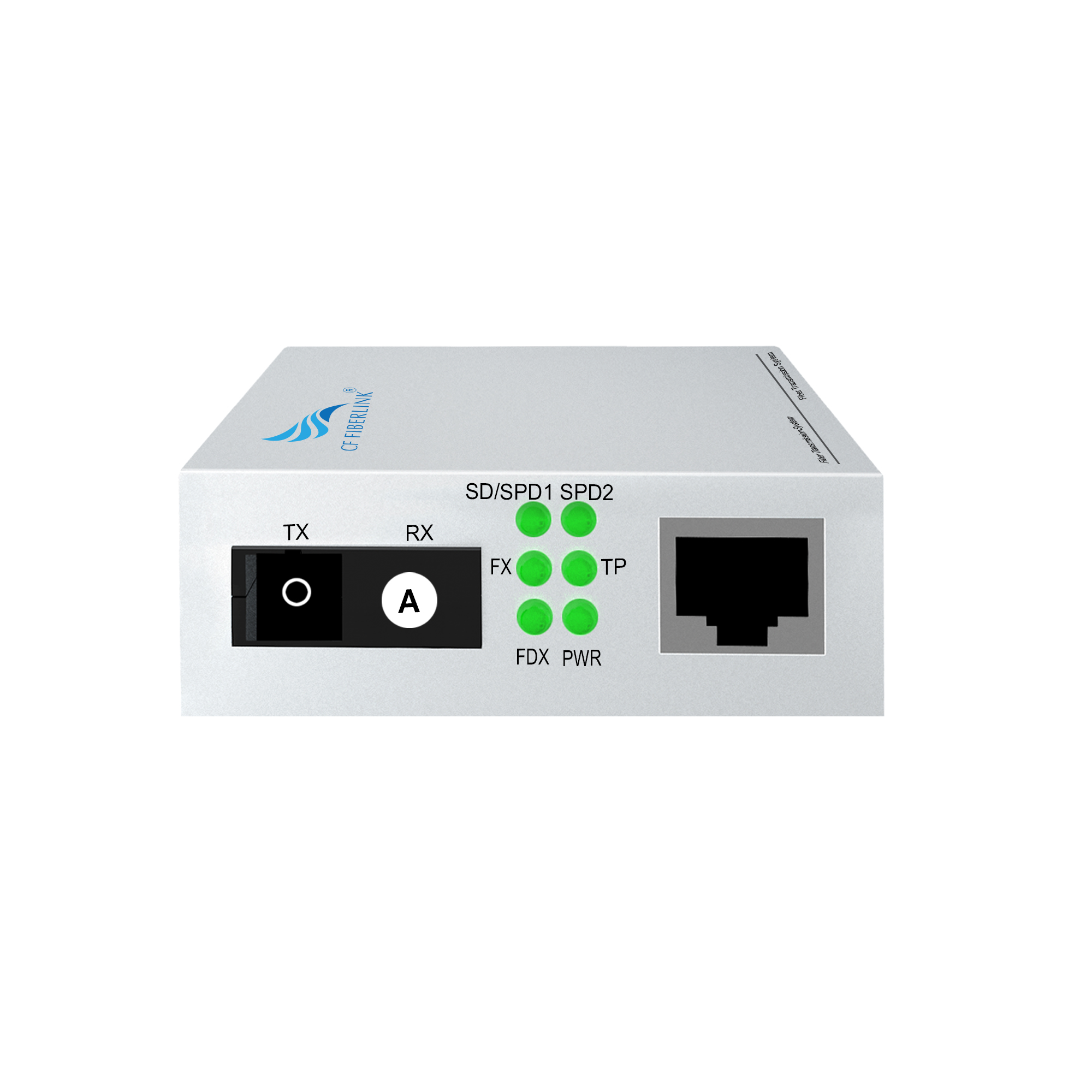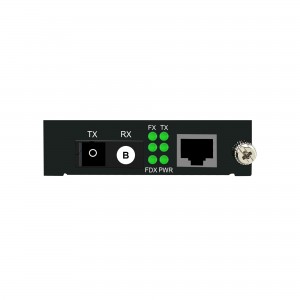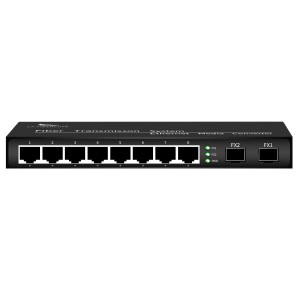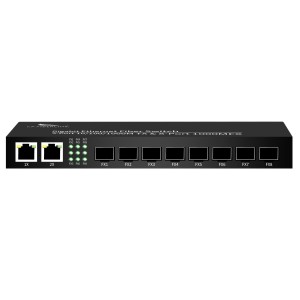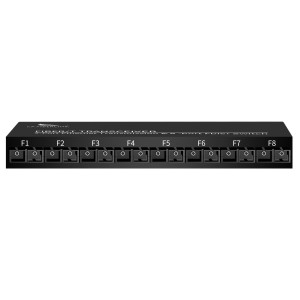2-port 10/100/1000M WDM Media Converter (Single-mode Single-fiber SC)
2-port 10/100/1000M WDM Media Converter (Single-mode Single-fiber SC)
Product Features:
The LED gigabit 1 optical 1 electrical single-mode single-fiber transceiver launched by Huizhou Changfei Optoelectronics Technology Co., Ltd. This advanced product combines the functions of a transceiver and an optical-to-electrical converter, making it an essential tool for modern business.
Huizhou Changfei Photoelectric Technology Co., Ltd. is a domestic manufacturer specializing in the production of industrial intelligent management switches, PoE switches, Ethernet switches, wireless bridges, and wireless 4G routers. Our goal is to provide innovative solutions that meet the changing needs of businesses around the world.
Our LED Gigabit 1 Light 1 Electrical Single Mode Single Fiber Transceiver is designed to simplify your network connections. With its compact size and plug-and-play functionality, it is easy to install and use by anyone, regardless of technical expertise. No more complicated setups or hours of troubleshooting – our transceivers deliver convenience and efficiency.
LED gigabit 1 optical 1 electrical single-mode single-fiber transceiver is not only easy to use, but also has excellent performance. Support gigabit transmission to ensure fast and stable data transmission rate. Whether you’re streaming multimedia content, transferring large files or holding a video conference, our transceivers guarantee an uninterrupted connection.
Another distinctive feature of our transceivers is their single-mode single-fiber capability. It optimizes bandwidth utilization and reduces costs by utilizing a single fiber to transmit and receive data. This is especially beneficial for businesses operating in demanding environments where efficient data transfer is critical.
We understand the importance of protecting your network infrastructure from unexpected events. That’s why our LED Gigabit 1 Optical 1 Electrical Single Mode Single Fiber Transceiver has 6KV lightning protection function. This ensures your network remains safe, even during thunderstorms or power surges.
Our transceivers feature a durable iron housing to withstand harsh environments. Its solid construction guarantees long-lasting performance, making it an excellent investment for businesses looking for reliable networking equipment.
To sum up, Huizhou Changfei Optoelectronics Technology Co., Ltd.’s LED gigabit 1 optical 1 electrical single-mode single-fiber transceiver is a cutting-edge product that integrates transceiver and photoelectric converter functions. With its plug-and-play installation, high-performance features, and advanced protection features, it’s the ideal solution for businesses of all sizes. Trust Huizhou Changfei Optoelectronics Technology Co., Ltd. to provide you with innovative network solutions to elevate your business to new heights.
What This Product Does
◇ CF-LED101GSW-20Ais a gigabit media converter, providing a gigabit RJ-45 port and a gigabit SC fiber port, which can convert between electrical and optical signals. How This Product Works
◇ CF-LED101GSW-20A adopts WDM (wavelength division multiplexing) technology, helping send and receive data at a distance of up to 20 km with only a single mode fiber, which saves half of the cable deployment cost for customers. CF-LED101GSW-20A transmits data at 1310 nm wavelength and receives data at 1550 nm wavelength on optical fiber. Therefore, the terminal device used in conjunction with the CF-LED101GSW-20Ashould send data at a wavelength of 1550 nm and receive data at a wavelength of 1310 nm. CF FIBERLINK another media converter CF-LED101GSW-20B is one of the products that can cooperate with CF-LED101GSW-20A.
Other Features
◇ Besides, this media converter can be used as a standalone device (no rack required) or used with CF FIBERLINK’s CF-2U14 rack for auto MDI/MDI-X in TX port in which duplex mode is automatically negotiated.
technical parameter:
| Model | CF-LED101GSW-20A | |
| Interface Characteristics | ||
| Fixed Port | 1* 1000Base-T RJ45 port
1* 1000Base-X uplink SC fiber port |
|
| Ethernet Port | 1000Base-T auto-sensing, full/half duplex MDI/MDI-X self-adaption | |
| Twisted Pair
Transmission |
10BASE-T: Cat3,4,5 UTP(≤100 meter)
100BASE-T: Cat5e or later UTP(≤100 meter) 1000BASE-T : Cat5e or later UTP(≤100 meter) |
|
| Optical Port | Default optical module is single-mode single-fiber 20km, SC port | |
| Wavelength/Distance | A-end: RX1310nm / RX1550nm 0 ~ 40KMB-end:RX1550nm/ RX1310nm 0 ~ 40KM | |
| A-end: RX1490nm / RX1550nm 0 ~ 120KMB-end:RX1550nm/ RX1490nm 0 ~ 120KM | ||
| Chip Parameter | ||
| Network Protocol | IEEE802.3 10BASE-T, IEEE802.3i 10Base-T,IEEE802.3u 100Base-TX, IEEE802.3u 100Base-FX, IEEE802.3x
IEEE802.3ab 1000Base-T;IEEE802.3z 1000Base-X; |
|
| Forwarding Mode | Store and Forward(Full Wire Speed) | |
| Switching Capacity | 4Gbps | |
| Buffer Memory | 3Mpps | |
| MAC | 2K | |
| LED Indicator | Fiber | FX(green) |
| rate | SD/SPD1 (green)SPD2: 100/ 1000 (green) | |
| Data | TP (green) | |
| Single / duplex | FDX (green) | |
| Power | PWR (green) | |
| Power | ||
| Working Voltage | AC:100-240V | |
| Power Consumption | Standby<1W, Full load<5W | |
| Power Supply | DC:5V/2A industrial power supply | |
| Lightning protection &Certification | ||
| Lightning protection | Lightning protection: 4KV 8/20us, Protection level: IP30 | |
| Certification | CCC;CE mark, commercial; CE/LVD EN60950;FCC Part 15 Class B; RoHS | |
| Physical Parameter | ||
| Operation TEMP | -20~+55°C;5%~90% RH Non condensing | |
| Storage TEMP | -40~+85°C;5%~95% RH Non condensing | |
| Dimension (L*W*H) | 94mm* 71mm*27mm | |
| Installation | Desktop, CF-2U14 slot rack | |
Product Size:
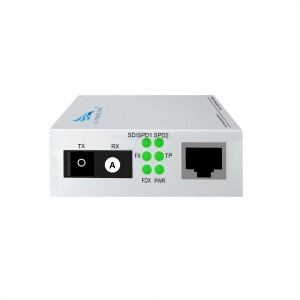
Product application diagra:

How to choose a fiber optic transceiver?
Optical fiber transceivers break the 100-meter limitation of Ethernet cables in data transmission. Relying on high-performance switching chips and large-capacity caches, while truly achieving non-blocking transmission and switching performance, they also provide balanced traffic, isolation and conflict. Error detection and other functions ensure high security and stability during data transmission. Therefore, fiber optic transceiver products will still be an indispensable part of actual network construction for a long time. So, how should we choose fiber optic transceivers?
1. Port function test
Mainly test whether each port can work normally in the duplex state of 10Mbps, 100Mbps and half-duplex state. At the same time, it should be tested whether each port can automatically select the highest transmission speed and automatically match the transmission rate of other devices. This test can be included in other tests.
2. Compatibility test
It mainly tests the connection ability between the optical fiber transceiver and other devices compatible with Ethernet and Fast Ethernet (including network card, HUB, Switch, optical network card, and optical switch). The requirement must be able to support the connection of compatible products.
3. Cable connection characteristics
Test the fiber optic transceiver’s ability to support network cables. First, test the connection ability of Category 5 network cables with lengths of 100m and 10m, and test the connection ability of long Category 5 network cables (120m) of different brands. During the test, the optical port of the transceiver is required to have a connection capability of 10Mbps and a rate of 100Mbps, and the highest must be able to connect to a full-duplex 100Mbps without transmission errors. Category 3 twisted pair cables may not be tested. Subtests can be included in other tests.
4. Transmission characteristics (transmission loss rate of data packets of different lengths, transmission speed)
It mainly tests the packet loss rate when the optical fiber transceiver optical port transmits different data packets, and the connection speed under different connection rates. For the packet loss rate, you can use the test software provided by the network card to test the packet loss rate when the packet size is 64, 512, 1518, 128 (optional) and 1000 (optional) bytes under different connection rates. , the number of packet errors, the number of packets sent and received must be more than 2,000,000. Test transmission speed can use perform3, ping and other software.
5. The compatibility of the whole machine to the transmission network protocol
It mainly tests the compatibility of fiber optic transceivers to network protocols, which can be tested in Novell, Windows and other environments. The following low-level network protocols such as TCP/IP, IPX, NETBIOS, DHCP, etc. must be tested, and the protocols that need to be broadcast must be tested. Optical transceivers are required to support these protocols (VLAN, QOS, COS, etc.).
6. Indicator status test
Test whether the status of the indicator light is consistent with the description of the panel and the user manual, and whether it is consistent with the current status of the fiber optic transceiver.


